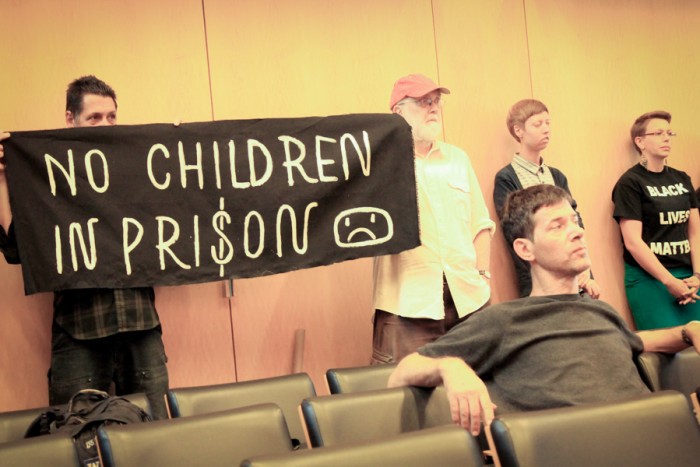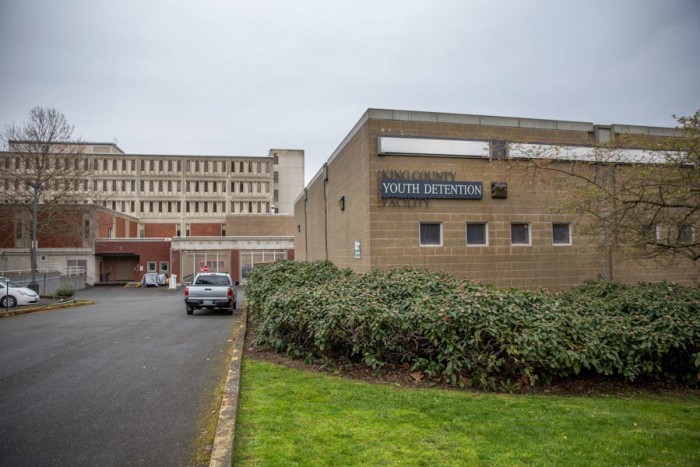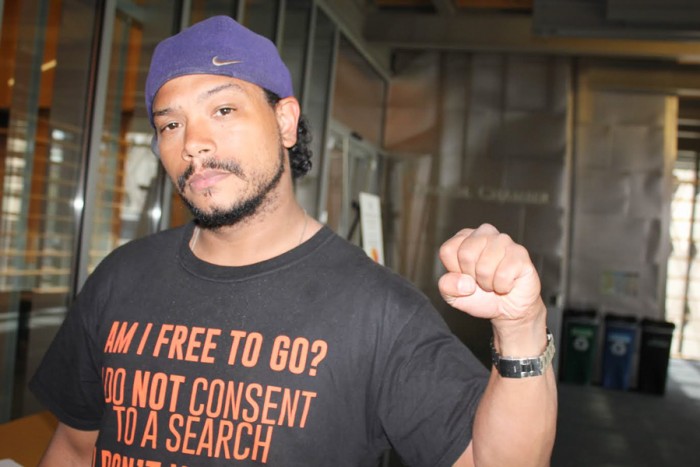
Resolution Zero Use of Detention for Juveniles (Resolution 31614) unanimously passed today at the full council meeting with a few amendments, including one indicating that communities oppose the King County Children and Family Justice Center. The amendment, which was suggested by community members last week, now says, ” …the communities organizing and leading the campaign against placing youth in detention oppose the construction of the King County Children and Family Justice Center and contend that the facility itself is inconsistent with the vision of zero use of detention for youth. “
17 at 6:20 pm:
The Seattle City Council Public Safety, Civil Rights, and Technology Committee passed a resolution Wednesday that would ban youth detention in the city.
Organizers turned out at the council chambers in support of the resolution and said they’re hopeful it will be amended to more explicitly discourage the construction of the planned King County Children and Family Justice Center before it goes before the full council on Monday.
Resolution 31614 envisions Seattle as a city with zero use of detention as a disciplinary measure for minors, replacing it with with city-funded, community-based programs that help youth correct delinquent or criminal behavior without removing them from their communities.
The resolution resoundingly passed with a unanimous vote by the committee, including Council Members Bruce Harrell, Sally Bagshaw and Nick Licata.
Council Member Mike O’Brien, whose office drafted and pushed the resolution to the committee, was present to answer questions from the committee members.
“The significance of this resolution is that it would mark Seattle as one of the first largest cities to a have commitment to zero youth incarceration,” said Rose Harriot, a citizen who spoke in support of it at the meeting.
Along with others, she cautioned the committee not to “water down” the resolution with amendments. The committee members expressed their explicit support for the resolution before proceeding with their questions and suggestions.

“They listened,” said Sarra Tekola, a legislative assistant to O’Brien, speaking of the overwhelmingly friendly committee.
However, members of the audience at one point vocally expressed their dissatisfaction when Council Member Bagshaw asked if elimination of youth jail would include those held for violent crimes.
Shouts of “they are children!” rang through the chambers.
In a more measured response to Bagshaw’s question, community member Michael Moynihan detailed alternative conflict resolution and crime restitution mechanisms that have worked in other places.
I spoke to Moynihan after the hearing and he described his first hand experience with the youth jail system.
“I grew up here in Seattle, in the gangs and what not, and go into quite a bit of trouble: four felonies, sent up into juvenile prison, did that whole gamut,” he said. “But there is a difference between me and some of the other people [in jail] that I grew up with: the community engagement.”
“A lot of this was informal,” he said, explaining how attention from community groups helped him turn his life around. “They are just little organizations like the Youth Orion Center or Arts Corps…that reached out to me, that informed me that I was worth their time, their energy and respect, and they encouraged me to pursue greater things in my life.”

O’Brien’s office first started working on a draft of the resolution by adopting the recommendations of a racial equity analysis conducted by the Office for Civil Rights (OCR) in June.
“It did come out of OCR’s racial impact assessment,” Tekola said, “what they found was that…although we’ve decreased our incarceration of juveniles overall, we’ve increased our incarceration of black youth.”
However, the initial draft adopted from OCR recommendations was rejected by community organizations, which O’Brien and his staff were keen on getting input from. The organizations included Ending the Prison Industrial Complex (EPIC), No New Youth Jail, European Dissent and many others.
“Initially, we were gonna adopt the OCR recommendations which included building the new youth jail in a way where it can be designed to be convertible, so we can convert the cells into rooms.” Tekola said, “But the community said, ‘no, if you want adopt the strategy of detention zero, you can’t simultaneously adopt building a new youth jail’”
Location was a main point of contention — the idea of a “convertible” youth jail on the site of the current facility in the Central District was in conflict with the desire to keep delinquent youth in their own community and work on restorative justice, Tekola said.
“So we ended up scrapping our initial resolution and redrafting it based on community input,” she said.
Despite the intensive feedback, the resolution doesn’t directly address whether the new youth jail will be constructed… yet.
Ariel Hart, who sat at the committee table representing EPIC, suggested an amendment be made by alerting the committee that there was a ‘contradiction’ between the resolution and the planned new King County Youth Justice Center.
“If the resolution is passed, Seattle can’t use that juvenile [jail].” Moynihan told me optimistically.
After more input and discussions, committee chair Bruce Harrell moved the resolution to a vote with carefully agreed upon improvements on the language, intention, and potential amendments with the promise of not watering it down.
“So far so good and we will see — probably on Monday — what is gonna happen with this,” Tekola said.
This story has been updated since it was first published to include updates on the full council vote and correct that Nick Licata voted for the original resolution, not Tim Burgess as was originally reported.
King County officials also asked that we clarify that, while the proportion of incarcerated youth who are black is around 50%, the total number of black youth incarcerated in King County has actually decreased. According to Cameron Satterfield of King County Executive Services, in 2009 we had 2,146 youth of color out of 3,238 youth admitted to detention. In 2014, we had 1,543 youth of color out of 2,111 youth admitted to detention.


Burgess was not there, nor is he on the committee.
Thanks for the correction, Um. I appreciate it.